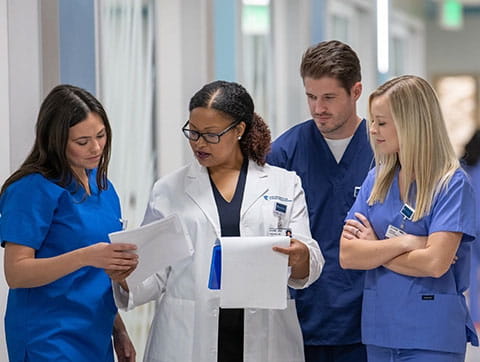Aortic Aneurysm
An aortic aneurysm is a weak spot in the wall of the body’s main artery, which is called the aorta. An aortic aneurysm is a balloon-like bulge that can be caused by the pressure from blood flow. Aortic aneurysms that rupture cause internal bleeding that can be fatal.
At The University of Kansas Health System, you’ll receive expert, comprehensive care for aortic aneurysms from our multidisciplinary team. Our multidisciplinary vascular care team provides advanced treatment for aneurysms affecting any part of the body aside from the brain. Our neurologists and neurosurgeons treat brain aneurysms.
What is an aortic aneurysm?
When a weak spot develops in the wall of the aorta, 2 issues may arise:
- The bulge or balloon may burst causing blood from the aorta to pour into the body.
- The pressure of the blood flow in the vessel may cause the inner layers to tear, which is called an aortic dissection.
Aneurysms can occur in any blood vessel in the body, including those in the :
- Abdomen and pelvis (abdominal aorta and iliac arteries)
- Chest (ascending and thoracic aorta, innominate artery, subclavian artery)
- Legs (femoral and popliteal arteries)
- Neck (carotid artery)
Aneurysms occur most commonly in the aorta, which is the body’s main artery that carries blood from the heart, or the brain. The Centers for Disease Control and Prevention reports that each year, about 10,000 people in the US die from ruptured aortic aneurysms. It is the 10th leading cause of death for men over age 50.
We offer a variety of appointment types. Learn more or call 913-588-1227 to schedule now.
Aortic aneurysm symptoms and risks
The symptoms of an aneurysm depend on its type, location and whether it has ruptured or is interfering with the body’s other organs or functions. Aneurysms can grow for years without symptoms and are often found during testing for other health issues.
Factors that may increase your risk for aortic aneurysm include:
- Age
- Atherosclerosis (hardening of the arteries)
- Family history of aneurysm, heart disease or other arterial diseases
- Genetic conditions including:
- Ehlers Danlos syndrome
- Marfan syndrome
- Loeys Dietz syndrome
- High blood pressure, also called hypertension
- Illicit drug use
- Smoking – all males over age 65 with a history of tobacco use should be screened for abdominal aortic aneurysm
- Trauma
Aortic aneurysm diagnosis and screening
The location of the aneurysm guides which diagnostic and imaging method might be used. Possible testing includes ultrasound, computed tomography (CT) scans and magnetic resonance imaging (MRI).
Genetics also plays an important role in aneurysm development, although we have not identified all the contributing genes. If you have a family history of aneurysm or identifiers of genetic disease, we may suggest screening studies or genetic testing for your family members.
In addition to genetics, there are some risk factors you can change:
- Quit smoking
- Control your blood pressure
- Control your cholesterol
- Exercise regularly
- Eat a healthy diet
Aortic aneurysm treatment
Medical management and monitoring
If you have an aneurysm, we will likely recommend regular imaging tests based on the size and location of the aneurysm.
In addition, managing other medical conditions such as high blood pressure and high cholesterol can help slow the growth of aortic aneurysms and should be part of your care. If you smoke, we can help you quit or cut back, which can also slow the growth of aneurysms.
Surgery
If your aortic aneurysm is a certain size, has grown quickly or is symptomatic, your doctor may recommend you have surgery. Several factors, including its location and size, your age and any underlying medical conditions will affect your treatment options. These may include:
- Open surgery, which involves removing the damaged section of the aorta and replacing it with a synthetic tube, called a graft, which is stitched into place.
- Endovascular repair is a minimally invasive procedure where the aortic aneurysm is repaired from the inside. Surgeons route a stent graft through the artery and place it in the location of the aneurysm. Depending on the location, your surgeon may use the artery in your groin, arm or chest to place the start graft into the aorta.
The risks of open and endovascular surgery vary depending on the aneurysm location. For detailed risks specific to your aneurysm and procedure, talk with your surgeon.
Follow-up appointments and imaging after aneurysm repair are essential for complete healing with no complications. Regular visits with your specialist are also important because aneurysms can develop at other locations in the body.
Why choose us for aortic aneurysm treatment
- Cardiovascular anesthesiologists on our team are trained and certified in transesophageal echocardiography (TEE). These specialists use TEE to help guide stent placement.
- Our team was the first in the region to complete graft-based thoracic aortic aneurysm surgery as well as the first to perform an abdominal aneurysm graft. We have more experience with stent grafts than any team in the area.




